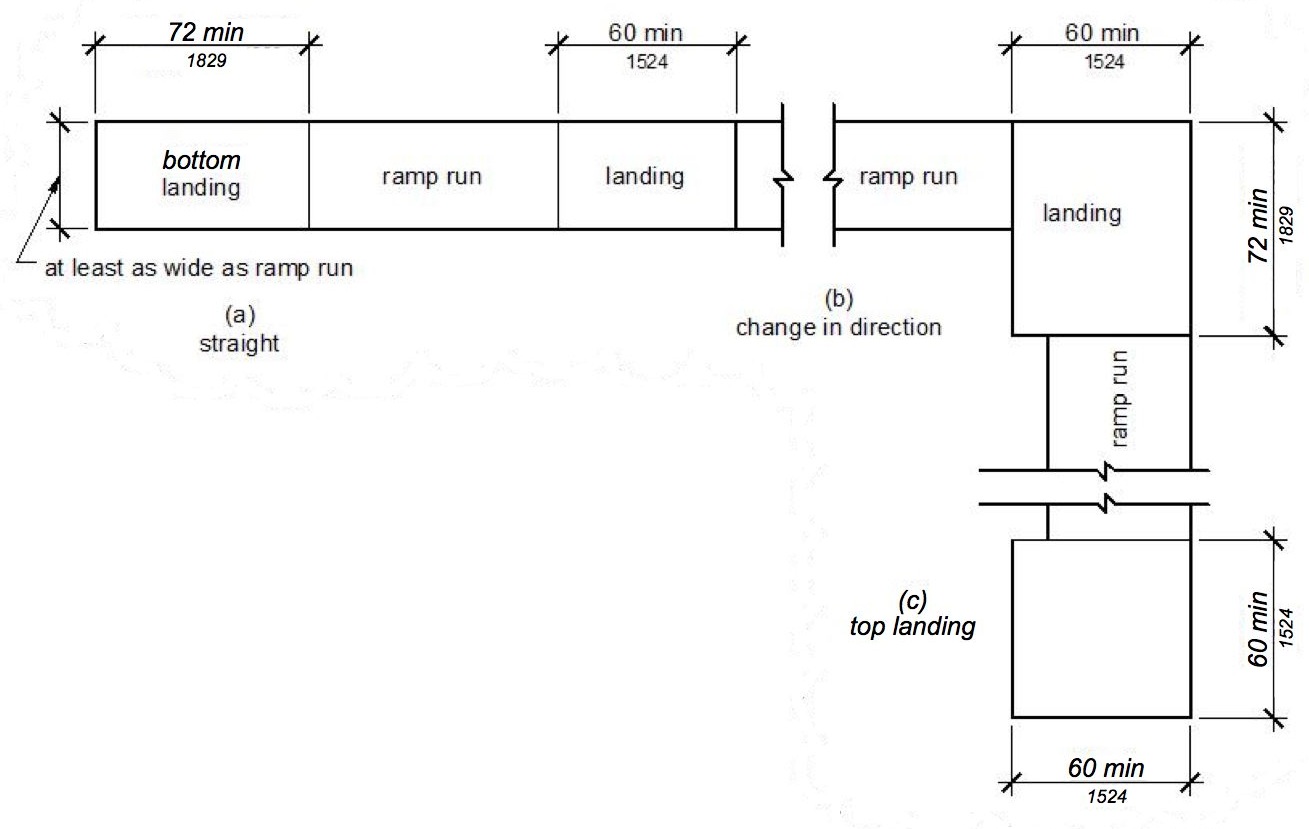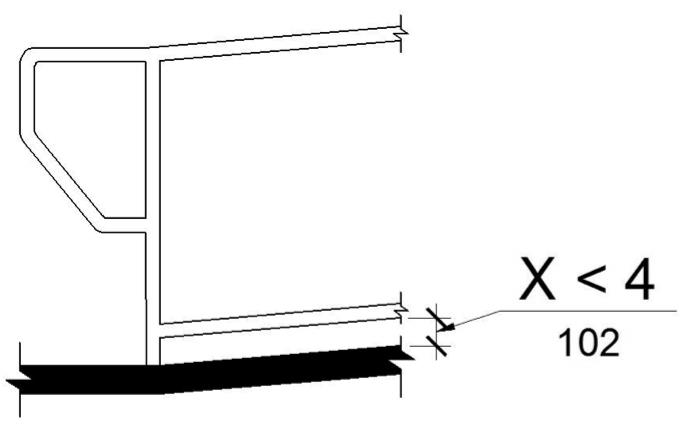2013 California Standards for Accessible Design Pocket Guide
11B-405 RAMPS
11B-405.1 General.
Ramps on accessible routes shall comply with Section 11B-405.
Exception: In assembly areas, aisle ramps adjacent to seating and not serving elements required to be on an accessible route shall not be required to comply with Section 11B-405.
11B-405.2 Slope.
Ramp runs shall have a running slope not steeper than 1:12.
Exception: Reserved.
[2010 ADAS] EXCEPTION: In existing sites, buildings, and facilities, ramps shall be permitted to have running slopes steeper than 1:12 complying with Table 405.2 where such slopes are necessary due to space limitations.
|
Table 405.2 Maximum Ramp Slope and Rise for Existing Sites, Buildings, and Facilities |
|
|---|---|
|
Slope1 |
Maximum Rise |
|
Steeper than 1:10 but |
3 inches (75 mm) |
|
Steeper than 1:12 but |
6 inches (150 mm) |
|
1. A slope steeper than 1:8 is prohibited. |
|
ETA Editor's Note
Lacking the Exception at 11B-405.2, 2013 CBC is more stringent at existing ramps than 2010 ADAS.
11B-405.3 Cross slope.
Cross slope of ramp runs shall not be steeper than 1:48.

11B-405.4 Floor or ground surfaces.
Floor or ground surfaces of ramp runs shall comply with Section 11B-302. Changes in level other than the running slope and cross slope are not permitted on ramp runs.
11B-405.5 Clear width.
The clear width of a ramp run shall be 48 inches (1219 mm) minimum.
Exceptions:
1. Within employee work areas, the required clear width of ramps that are a part of common use circulation paths shall be permitted to be decreased by work area equipment provided that the decrease is essential to the function of the work being performed.
2. Handrails may project into the required clear width of the ramp at each side 3½ inches (89 mm) maximum at the handrail height.
3. The clear width of ramps in residential uses serving an occupant load of fifty or less shall be 36 inches (914 mm) minimum between handrails.
[2010 ADAS] 405.5 Clear Width. The clear width of a ramp run and, where handrails are provided, the clear width between handrails shall be 36 inches (915 mm) minimum.
EXCEPTION: Within employee work areas, the required clear width of ramps that are a part of common use circulation paths shall be permitted to be decreased by work area equipment provided that the decrease is essential to the function of the work being performed.
ETA Editor's Note
2013 CBC is more stringent regarding ramp width than 2010 ADAS.
11B-405.6 Rise.
The rise for any ramp run shall be 30 inches (762 mm) maximum.
11B-405.7 Landings.
Ramps shall have landings at the top and the bottom of each ramp run. Landings shall comply with Section 11B-405.7.

RAMP LANDINGS
11B-405.7.1 Slope.
Landings shall comply with Section 11B-302. Changes in level are not permitted.
Exception: Slopes not steeper than 1:48 shall be permitted.
11B-405.7.2 Width.
The landing clear width shall be at least as wide as the widest ramp run leading to the landing.
11B-405.7.2.1.
Top landings shall be 60 inches (1524 mm) wide minimum.
11B-405.7.3 Length.
The landing clear length shall be 60 inches (1524 mm) long minimum.
11B-405.7.3.1.
Bottom landings shall extend 72 inches (1829 mm) minimum in the direction of ramp run.
11B-405.7.4 Change in direction.
Ramps that change direction between runs at landings shall have a clear landing 60 inches (1525 mm) minimum by 72 inches (1829 mm) minimum in the direction of downward travel from the upper ramp run.
[S.H. 1133B.5.4.5] [Safe Harbor only applies to existing exterior ramps leading to a primary entrance.]
[2010 ADAS] 405.7.4 Change in Direction. Ramps that change direction between runs at landings shall have a clear landing 60 inches (1525 mm) minimum by 60 inches (1525 mm) minimum.
11B-405.7.5 Doorways.
Where doorways are located adjacent to a ramp landing, maneuvering clearances required by Sections 11B-404.2.4 and 11B-404.3.2 shall be permitted to overlap the required landing area. Doors, when fully open, shall not reduce the required ramp landing width by more than 3 inches (76 mm). Doors, in any position, shall not reduce the minimum dimension of the ramp landing to less than 42 inches (1067 mm).
[2010 ADAS] 405.7.5 Doorways. Where doorways are located adjacent to a ramp landing, maneuvering clearances required by 404.2.4 and 404.3.2 shall be permitted to overlap the required landing area.
ETA Editor's Note
Since 2010 ADAS makes no distinction between top, bottom and intermediate landings, 2013 CBC is more stringent regarding ramp landings. Also, 2013 CBC allows less encroachment of doors onto ramp landings.
11B-405.8 Handrails.
Ramp runs shall have handrails complying with Section 11B-505.
[2010 ADAS] 405.8 Handrails. Ramp runs with a rise greater than 6 inches (150 mm) shall have handrails complying with 505.
Exceptions:
1. Reserved.
2. Reserved.
3. Curb ramps do not require handrails.
4. At door landings, handrails are not required on ramp runs less than 6 inches (152 mm) in rise or 72 inches (1829 mm) in length.
[2010 ADAS] EXCEPTION: Within employee work areas, handrails shall not be required where ramps that are part of common use circulation paths are designed to permit the installation of handrails complying with 505. Ramps not subject to the exception to 405.5 shall be designed to maintain a 36 inch (915 mm) minimum clear width when handrails are installed.
ETA Editor's Note
Since 2013 CBC lacks the Exception at employee work areas, and since it requires handrails at short ramps that are not curb ramps, 2013 CBC is more stringent regarding ramp handrails than 2010 ADAS.
11B-405.9 Edge protection.
Edge protection complying with Section 11B-405.9.2 shall be provided on each side of ramp runs and at each side of ramp landings.
[2010 ADAS] 405.9 Edge Protection. Edge protection complying with 405.9.1 or 405.9.2 shall be provided on each side of ramp runs and at each side of ramp landings.
Exceptions:
1. Edge protection shall not be required on ramps that are not required to have handrails and have sides complying with Section 11B-406.2.2.
2. Edge protection shall not be required on the sides of ramp landings serving an adjoining ramp run or stairway.
3. Edge protection shall not be required on the sides of ramp landings having a vertical drop-off of ½ inch (12.7 mm) maximum within 10 inches (254 mm) horizontally of the minimum landing area specified in Section 11B-405.7.
11B-405.9.1 Reserved.
[2010 ADAS] 405.9.1 Extended Floor or Ground Surface. The floor or ground surface of the ramp run or landing shall extend 12 inches (305 mm) minimum beyond the inside face of a handrail complying with 505.
11B-405.9.2 Curb or barrier.
A curb, 2 inches (51 mm) high minimum, or barrier shall be provided that prevents the passage of a 4 inch (102 mm) diameter sphere, where any portion of the sphere is within 4 inches (102 mm) of the finish floor or ground surface. To prevent wheel entrapment, the curb or barrier shall provide a continuous and uninterrupted barrier along the length of the ramp.

CURB OR BARRIER EDGE PROTECTION
ETA Editor's Note
2013 CBC requires either a curb or a barrier for edge protection at ramps, and does not recognize the extended floor or ground surface also permitted by 2010 ADAS.
11B-405.10 Wet conditions.
Landings subject to wet conditions shall be designed to prevent the accumulation of water.

User Comments/Questions
Add Comment/Question